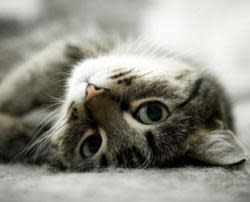Does Your Cat Get Pimples? Don't Worry, It's Normal
By WebVet.com

Cat acne is a poorly understood condition in which too much keratin (a protein found in the outer layer of skin) and sebum (the natural oily "moisturizer" produced by the skin) are produced. This excess keratin and sebum becomes trapped in the hair follicles, resulting in the formation of comedones, or "blackheads." These comedones are frequently infected with bacteria and yeast, and form pustules.
Feline chin acne looks similar to human acne, but it is not hormonally mediated or restricted to puberty. Allergies may play a role.
In cases of cat acne, the chin is dark and flaky, and manifests tiny black plugs. Blackheads may also appear on both the lower and upper lips. As part of feline chin acne, bacterial and yeast infections may result in red, infected pustules and pimples. In long-term cases, firm, crusty, painful nodules may develop.
Diagnosis of cat acne is based on the history and physical examination. Diagnostic tests can include bacterial and fungal cultures, skin scrapings for mites, and allergy testing.
Treatment often begins with improved hygiene. Topical treatment with medications that contain benzoyl peroxide is often effective. Other medications, such as antibiotics, fatty acid supplements, or agents active against yeast may also be used, especially in more severe or chronic cases. Only ceramic, glass, or stainless steel dishes should be used for food and water, and all dishes should be washed in hot soapy water every day.
Q&A
What is feline acne?
Feline acne is a poorly understood condition in which too much dead skin and oil build up, leading to the formation of pimples and secondary infections on the chin.
Is this condition similar to human acne?
Feline chin acne looks similar to human acne, but it is not hormonally mediated or restricted to puberty.
How is this condition treated?
Treatment involves cleansing the chin to remove oils and dead cells, then applying topical medications such as benzoyl peroxide cream. Other medications, including antibiotics, fatty acid supplements, or agents active against yeast, are sometimes needed.
Check out more from WebVet:
